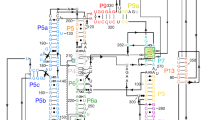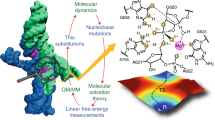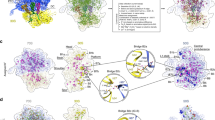Abstract
The formation of individual tertiary contacts of the Tetrahymena L-21 Sca I ribozyme has been monitored by hydroxyl radical footprinting and its global conformation by analytical ultracentrifugation as a function of monovalent ion concentration in the absence of divalent ions. Advanced methods of data analysis, which allow the hydroxyl radical reactivity of every nucleotide to be quantified, permit monitoring of each and every structural element of the RNA. Monovalent ion-mediated global compaction of the ribozyme is accompanied by the formation of native tertiary contacts; most native tertiary contacts are evident except several that are located near where divalent ions are observed in crystallographic structures. Non-native tertiary contacts are also observed at low but not high concentrations of monovalent ions. In light of recent studies that have shown that the presence of monovalent ions greatly accelerates the Mg2+-dependent folding of the Tetrahymena ribozyme, the present studies suggest that Na+ concentration changes not only the starting position of the RNA on its folding funnel but also pushes it deep into the well by forming native tertiary contacts and, thus, favoring fast and correct folding pathways.
This is a preview of subscription content, access via your institution
Access options
Subscribe to this journal
Receive 12 print issues and online access
$189.00 per year
only $15.75 per issue
Buy this article
- Purchase on Springer Link
- Instant access to full article PDF
Prices may be subject to local taxes which are calculated during checkout





Similar content being viewed by others
References
Piccirilli, J.A., Vyle, J.S., Caruthers, M.H. & Cech, T.R. Nature 361, 85–88 (1993).
Downs, W.D. & Cech, T.R. RNA 2, 718–732 (1996).
Russell, R., Millett, I.S., Doniach, S. & Herschlag, D. Nature Struct. Biol. 7, 367–370 (2000).
Buchmueller, K.L., Webb, A.E., Richardson, D.A. & Weeks, K.M. Nature Struct. Biol. 7, 362–366 (2000).
Fang, X. et al. Biochemistry 39, 11107–11113 (2000).
Heilman-Miller, S.L., Pan, J., Thirumalai, D. & Woodson, S.A. J. Mol. Biol. 309, 57–68 (2001).
Heilman-Miller, S.L., Thirumalai, D. & Woodson, S.A. J. Mol. Biol. 306, 1157–1166 (2001).
Russell, R. & Herschlag, D. J. Mol. Biol. 291, 1155–1167 (1999).
Silverman, S.K., Deras, M.L., Woodson, S.A., Scaringe, S.A. & Cech, T.R. Biochemistry 39, 12465–12475 (2000).
Russell, R. et al. Proc. Natl. Acad. Sci. USA 99, 155–160 (2002).
Deras, M.L., Brenowitz, M., Ralston, C.Y., Chance, M.R. & Woodson, S.A. Biochemistry 39, 10975–10985 (2000).
Uchida, T., He, Q., Ralston, C.Y., Brenowitz, M. & Chance, M.R. Biochemistry 41, 5799–5806 (2002).
Strahs, D. & Brenowitz, M. J. Mol. Biol. 244, 494–510 (1994).
Shadle, S.E. et al. Nucleic Acids Res. 25, 850–860 (1997).
Celander, D.W. & Cech, T.R. Science 251, 401–407 (1991).
Sclavi, B., Woodson, S., Sullivan, M., Chance, M.R. & Brenowitz, M. J. Mol. Biol. 266, 144–159 (1997).
Sclavi, B., Sullivan, M., Chance, M.R., Brenowitz, M. & Woodson, S.A. Science 279, 1940–1943 (1998).
Ralston, C.Y., He, Q., Brenowitz, M. & Chance, M.R. Nature Struct. Biol. 7, 371–374 (2000).
Cech, T.R., Damberger, S.H. & Gutell, R.R. Nature Struct. Biol. 1, 273–280 (1994).
Cate, J.H., Hanna, R.L. & Doudna, J.A. Nature Struct. Biol. 4, 553–558 (1997).
Cate, J.H. et al. Science 273, 1678–1685 (1996).
Cate, J.H. et al. Science 273, 1696–1699 (1996).
Golden, B.L., Gooding, A.R., Podell, E.R. & Cech, T.R. Science 282, 259–264 (1998).
Lehnert, V., Jaeger, L., Michel, F. & Westhof, E. Chem. Biol. 3, 993–1009 (1996).
Cate, J.H. & Doudna, J.A. Structure 4, 1221–1229 (1996).
Zheng, M., Wu, M. & Tinoco, I. Jr Proc. Natl. Acad. Sci. USA 98, 3695–3700 (2001).
Christian, E.L. & Yarus, M. Biochemistry 32, 4475–4480 (1993).
Berens, C., Streicher, B., Schroeder, R. & Hillen, W. Chem. Biol. 5, 163–175 (1998).
Wu, M. & Tinoco, I. Jr Proc. Natl. Acad. Sci. USA 95, 11555–11560 (1998).
Silverman, S.K. & Cech, T.R. RNA 7, 161–166 (2001).
Russell, R. et al. Proc. Natl. Acad. Sci. USA 99, 4266–4271 (2002).
Pan, J. & Woodson, S.A. J. Mol. Biol. 280, 597–609 (1998).
Pan, J., Deras, M.L. & Woodson, S.A. J. Mol. Biol. 296, 133–144 (2000).
Zaug, A.J., Grosshans, C.A. & Cech, T.R. Biochemistry 27, 8924–8931 (1988).
Lingner, J. & Keller, W. Nucleic Acids Res. 21, 2917–2920 (1993).
Latham, J.A., Zaug, A.J. & Cech, T.R. Methods Enzymol. 181, 558–569 (1990).
Tullius, T.D., Dombroski, B.A., Churchill, M.E. & Kam, L. Methods Enzymol. 155, 537–558 (1987).
Wang, X.D. & Padgett, R.A. Proc. Natl. Acad. Sci. USA 86, 7795–7799 (1989).
Emerick, V.L. & Woodson, S.A. Proc. Natl. Acad. Sci. USA 91, 9675–9679 (1994).
Philo, J.S. Biophys. J. 72, 435–444 (1997).
Hinz, H.-J. Thermodynamic Data for Biochemistry and Biotechnology (Springer-Verlag, New York; 1986).
Glasel, J.A. & Deutscher, M.P. Introduction to Biophysical Methods for Protein and Nucleic Acid Research (Academic Press, San Diego; 1995).
Pastor, N., Weinstein, H., Jamison, E. & Brenowitz, M. J. Mol. Biol. 304, 55–68 (2000).
Brenowitz, M., Senear, D.F., Shea, M.A. & Ackers, G.K. Methods Enzymol. 130, 132–181 (1986).
Sclavi, B., Woodson, S., Sullivan, M., Chance, M. & Brenowitz, M. Methods Enzymol. 295, 379–402 (1998).
Hill, A.V. J. Physiol. (London) 40, iv–vii (1910).
Acknowledgements
We thank D. Herschlag and R. Russell for pre-publication discussion of their results. This work was supported by grants from the National Institute of General Medical Sciences and the Biomedical Technology Program of the Division of Research Resources.
Author information
Authors and Affiliations
Corresponding author
Ethics declarations
Competing interests
The authors declare no competing financial interests.
Rights and permissions
About this article
Cite this article
Takamoto, K., He, Q., Morris, S. et al. Monovalent cations mediate formation of native tertiary structure of the Tetrahymena thermophila ribozyme. Nat Struct Mol Biol 9, 928–933 (2002). https://doi.org/10.1038/nsb871
Received:
Accepted:
Published:
Issue Date:
DOI: https://doi.org/10.1038/nsb871
This article is cited by
-
How do metal ions direct ribozyme folding?
Nature Chemistry (2015)



